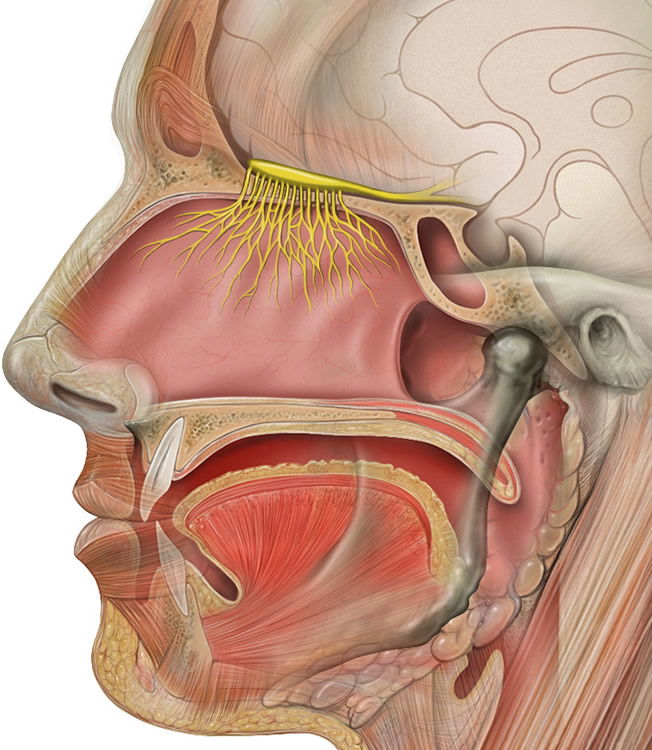
Humans’ Poor Sense of Smell Is an Evolutionary Myth
News to Know
Abstract
Evolution did not build your big brain at the expense of your sniffer.
News Source
- Tech Times: “The Human Sense Of Smell Is Better Than Previously Thought: How Did Our Sense Of Smell Evolve?”
- Tech Times: “Humans’ Sense of Smell Is Just As Good As Dogs’: Study”
At-a-Glance
- The notion that humans have a substandard sense of smell compared to mammalian animals is a myth.
- The myth of substandard human olfaction is rooted in evolutionary beliefs, not scientific observation.
- The human olfactory system has the earmarks of God’s great design.
We’ve all heard that, compared to mammalian animals like dogs, humans have a poor sense of smell. Did you know that this notion is a 19th century myth? And that this commonly accepted myth is based on an evolutionary idea rather than scientific evidence?
“Poor Human Olfaction Is a 19th Century Myth”—Rutgers University neuroscientist John McGann’s review published in Science—traces the origin and consequences of this belief and reviews evidence to the contrary. How good a sniffer you are, it turns out, depends on what you’re trying to sniff out and how you measure olfactory quality and ability.
Your Sense of Smell—How It Works
Let’s take a look at how your sense of smell works. The sense of smell—olfaction—involves detection of airborne chemicals. Molecules—whether from a fragrant flower, baking bread, grilling burgers, or your skunky feet—float around in the air. When they enter your nose, they dissolve in the mucus produced by the olfactory epithelium lining the upper part of your nasal passages. Embedded in this lining are millions of specialized neurons called olfactory receptor cells. Each kind of receptor is keyed to detect a certain kind of molecule. When a receptor detects a target molecule, it sends a signal to a nearby part of the brain called the olfactory bulb.
Olfactory bulbs receive direct input from olfactory receptor cells. These ovoid bulbous structures are located toward the front of the brain. This makes sense because that’s also where land mammals generally keep their noses. In humans and large primate animals, paired olfactory bulbs are located above the nasal passages where they are slightly flattened beneath the brain’s large frontal lobes. In rodents and many other mammals, the olfactory bulbs are prominently located at the front of the brain and comprise a proportionately larger part of it.
Smells can trigger our memories, stir our emotions, influence our behavior, and promote physiological responses.
From the olfactory bulbs, the information about detectable smells is forwarded to the rest of the brain. And to get the most from that information, it is combined with information from other receptors and sent to many different destinations. The olfactory bulbs achieve this by being highly organized. They contain spherical clusters (glomeruli) formed by the transmitting ends (axons) of the olfactory receptor cells and the receiving ends (dendrites) of many other neurons. Those neurons network the signals from many receptors and take the smell signals on to other destinations. Thus, smells can trigger our memories, stir our emotions, influence our behavior, and promote physiological responses. Modern research demonstrates that humans can even follow scent trails, and suggests that human social interaction is shaped through odor perception.1
The underestimation of human smell-ability is related to the comparative size of the brain’s olfactory bulbs in various mammals. Of course, there are small mammals with small brains and large mammals with large brains and humans with exceptionally large brains, but it is the proportional size of overall brain-to-olfactory bulb size that we are talking about here. Our olfactory bulbs, though larger than a mouse’s, for instance, are proportionately much smaller than the mouse’s when compared to overall brain size.

This side view of the human head shows the olfactory bulb located immediately above the olfactory receptor cells in the olfactory epithelium lining the upper nasal passages. The pair of olfactory bulbs is located just below the large frontal lobes of the brain. Image by Patrick J. Lynch, via Wikimedia Commons.
Vestigial Olfaction Myth
To understand how false evolutionary notions about olfaction came to be, we need to take a historical and anatomical detour through the brain’s speech center. Humans alone have brains equipped for language. The “language” part of the human brain is normally located only on one side. Nineteenth century French neuroanatomist Paul Broca discovered the part of the human brain’s dominant frontal lobe that is associated with speech, so it is called Broca’s area. Damage to this region impairs a person’s ability to speak.
Broca noted that many unique abilities defining human-ness are physically associated with the frontal lobes. The human brain is much larger than an ape’s, and a lot of that size difference comes from the large frontal lobes that house our advanced intellectual and linguistic capacity. Broca recognized that humans are not compulsively driven to behave in accordance with the information gathered by the sense of smell, whereas many mammals are. Therefore, beginning with Broca and continuing over the next few decades, it became accepted wisdom that humans had evolved their uniqueness, even their conscious free will, at the expense of their sense of smell.
Those who believed that humans were just highly evolved animals readily made assumptions connecting the comparative size of the smell-processing parts of the brain with the behavioral drives of animals and humans. Possession of a super-smelling ability was assumed to be associated with mammals lower on the evolutionary scale. Famous 19th century psychologist Sigmund Freud echoed this notion when he characterized the smell/taste/touch-driven early stage of childhood as a time “harking back to early animal forms of life.”2 Charles Judson Herrick’s 1924 tome Neurological Foundations of Animal Behavior described the human olfactory apparatus as “greatly reduced, almost vestigial” and declared that the olfactory abilities of “most other mammals gives them powers far beyond our comprehension.”3
It was assumed that because humans were so much more highly evolved than other mammals, they surely must have a poor sense of smell.
Thus it was assumed that because humans were so much more highly evolved than other mammals, they surely must have a poor sense of smell. The ability to smell must be vestigial! As with other body parts conveniently labeled as vestigial remnants of evolutionary history, the “vestigial” label long limited the scientific vision to investigate its functionality objectively. For a century, scientists didn’t bother to test this notion that people can’t smell well.
The evolutionary assumption that human smell is virtually vestigial has affected the interpretation of modern scientific observations, according to neuroscientist John McGann. To see this, let’s recall again how smell works. Odor receptors are cells with proteins to detect certain types of molecules. To detect lots of different smells, you have to have a lot of different types of odor receptors. When an odor receptor is triggered by its target molecule, a signal is sent to the olfactory bulb, and the brain interprets the signal as a particular odor.
Well, humans have about 1,000 genes encoding proteins for odor receptors. According to McGann’s review, investigators typically report that “only” 390 of these encode for functional odor receptors.4 The rest have been assumed to be useless “pseudogenes.” However, as with other assumptions that humans carry around a lot of genetic junk from an evolutionary past, this one should be junked.
It turns out that 60% of these so-called useless pseudogenes are transcribed into mRNA, indicating they are functional contributors to our olfactory process. Work is ongoing to discover what sorts of olfactory receptors these genes encode.5 Moreover, recent estimates suggest that humans, through the interaction of their odor receptors and their brains, can detect at least a trillion different scents.6 That number is up considerably from the mere 10,000 odors of popular wisdom.7
Gradually, evolutionary assumptions that human olfaction was left in the primitive dustbin are falling to the wayside as scientists discover our amazing capacity to smell. Yet McGann’s survey of smell literature, published in Science in May 2017, fails to offer any new evolutionary wisdom on the matter.
Humans and various animal species are well equipped to detect different sorts of smells to differing degrees and to interpret the information in ways that suit their needs.
What McGann’s survey does demonstrate, however, is that humans and various animal species are well equipped to detect different sorts of smells to differing degrees and to interpret the information in ways that suit their needs. And neither animal nor human is left short on the number of neurons devoted to olfaction. In fact, despite dramatic body and brain size differences, a mouse, a marmoset, and a person each has about 10 million olfactory neurons.8 But having a surprisingly similar number of neurons for smelling does not mean there are no unique qualities to human olfaction.
One of the biggest differences between the human olfactory system and those of animals is in the way the information-gathering neurons are organized. For instance, the human olfactory bulb is organized into 5,600 clusters of neurons (glomeruli). Recall that in each of these clusters connections is made between sensory neurons and the neurons that receive and process that information. This large number of glomeruli makes it possible for the information from each odor receptor to be processed in about 16 different places, compared to only about 2 in a mouse. Humans do not have a substandard sense of smell, but rather one entirely suited to help us interact with our world.
But Doesn’t the Vomeronasal Organ Show Evolution’s Footprints?
Many animals have an extra organ for smelling, the vomeronasal organ. The vomeronasal organ is a pair of pit-like structures high inside the nose. In animals these structures have a neural connection to an accessory olfactory bulb. The vomeronasal organ detects the scent of pheromones. Pheromones are chemical messengers that trigger behavioral responses in animals of the same species. Pheromones might, for instance, help an animal know it is time to mate.
Whether adult humans actually have functional vomeronasal organs is a matter of debate. The human embryo does, however, develop a vomeronasal organ. It serves as a scaffold for vital hormone secreting cells9 to migrate to their destination in the brain’s hypothalamus early in development. Once this cellular migration is complete, the organ regresses and the pathway disappears. No accessory olfactory bulb ever develops in the human.10
Careful study of the nasal passages of adult humans has, however, shown that a remnant of the vomeronasal organ may persist.11 Furthermore, its cells are probably functional, though just what they are doing is as yet unknown.12 Whether the vomeronasal organ retains any function in adult humans or not, its developmental role in human embryological development is not a vestige of evolutionary history. It is an example of an excellent developmental design by our wise Designer, the Creator God, who also designed all kinds of animals.
In short, God has designed humans with a smelling system of superior quality. We can detect not the few thousand odors pop wisdom claims, but “virtually all volatile chemicals [molecules that float in the air] larger than an atom or two.”13 Human noses can discriminate between an astounding number of scents. And those things we smell exert a tremendous effect on our emotions, our memories, and our perceptions. Of course, there is a lot of room for variation. The sense of smell tends to diminish with age. (There’s a shock!) And some people lose their sense of smell due to damage such as a head injury. There are even genetically mediated ethnic variations in the way we perceive certain smells. One study has found, for instance, that there are small variations in the human odor receptor gene OR7D4 among living populations and even in the Denisovan genome. Depending on which variation you have, a hormone produced by pigs (and hence, pork) smells either tasty or tainted.14
So where did the information to design such an elaborate olfactory system for humans as well as all the elaborately designed olfactory systems in animals come from? Molecules-to-man evolution cannot explain them. Neither genetic information nor the genetic systems to interpret and implement it spring into existence from nowhere. Like all information, they come from a source of information. They come from the Creator God of the Bible.
Further Reading
- Are “Vestigial Organs” Really “Proof of Evolution . . . on Your Body”?
- Vestigial Hiccups, Folding Fish-eyes, and Other Fables: Our Fishy Forebears . . . Again!
- Setting the Record Straight on Vestigial Organs
- Scars of Evolution or of a Sin-Cursed World?
For More Information: Get Answers
Remember, if you see a news story that might merit some attention, let us know about it! (Note: if the story originates from the Associated Press, FOX News, MSNBC, the New York Times, or another major national media outlet, we will most likely have already heard about it.) And thanks to all of our readers who have submitted great news tips to us. If you didn’t catch all the latest News to Know, why not take a look to see what you’ve missed?
(Please note that links will take you directly to the source. Answers in Genesis is not responsible for content on the websites to which we refer. For more information, please see our Privacy Policy.)
Footnotes
- John P. McGann, “Review Summary: Poor Human Olfaction Is a 19th-century Myth,” Science 356 (12 May 2017): 597, doi:10.1126/science.aam7263.
- S. Freud, Drei Abhandlungen zur Sexualtheorie (F. Deuticke, 38. Leipzig, 1905), quoted in McGann, “Review: Poor Human Olfaction Is a 19th-Century Myth.”
- C. J. Herrick, Neurological Foundations of Animal Behavior (Henry Holt and Company, New York, 1924), quoted in John P. McGann, “Review: Poor Human Olfaction Is a 19th-Century Myth.”
- John P. McGann, “Review: Poor Human Olfaction Is a 19th-Century Myth,” 2.
- Ibid.
- C. Bushdid et al., “Humans Can Discriminate More Than 1 Trillion Olfactory Stimuli,” Science 343, no. 6177 (2014):1370–1372, doi:10.1126/science.1249168.
- Some dispute that this number, a trillion, is too high, noting that it was derived through mathematical modeling rather than a scientific analysis of how many unique smells actually exist. See “ASU Researcher Disputes Claim That Humans Can Distinguish 1 Trillion Odors,” Arizona State University, July 7, 2015, https://asunow.asu.edu/content/asu-researcher-disputes-claim-humans-can-distinguish-1-trillion-odors to learn more.
- C. J. Herrick, Neurological Foundations of Animal Behavior (Henry Holt and Company, New York, 1924), quoted in John P. McGann, “Review: Poor Human Olfaction Is a 19th-Century Myth,” 3.
- These are GnRH-secreting cells. Gonadotropin-Releasing Hormone (GnRH)-secreting cells migrate along this temporary pathway from the place where they originally form—in the region of the embryonic nose—to the front part of the hypothalamus. Your hypothalamus gives your brain’s instructions to your pituitary gland, which produces many hormones. GnRH from the hypothalamus controls the pituitary’s production of the hormones that ultimately stimulate production of sex steroids. Thus, our Common Designer, the Creator God, has used a common design—the vomeronasal organ—to equip animals to attract mates and to lay down the pathways for the earliest phases of sexual development in human embryos. The pathway disappears when no longer needed, and the accessory olfactory organ associated with the vomeronasal organ in animals never develops in human embryos. It now appears that the embryonic vomeronasal organ, once completing its function as a scaffold along which other cells migrate, may differentiate into a functional structure in mature humans.
- D. Trotier, “Vomeronasal Organ and Human Pheromones,” European Annals of Otorhinolaryngology, Head and Neck Diseases 4, no. 128 (September 2011):184–190, doi:10.1016/j.anorl.2010.11.008.
- M. Witt, B. Georgiewa, M. Knecht, and T. Hummel, “On the Chemosensory Nature of the Vomeronasal Epithelium in Adult Humans,” Histochemistry and Cell Biology 117 no. 6: 493–509, doi:10.1007/s00418-002-0407-1.
- E. Shirokova, J.D. Raguse, W. Meyerhof, D. Krautwurst, “The Human Vomeronasal Type-1 Receptor Family—Detection of Volatiles and cAMP Signaling in HeLa/Olf Cells,” FASEB J 22 no. 5 (2008): 1416–25. doi:10.1038/srep00172.
- C. J. Herrick, Neurological Foundations of Animal Behavior (Henry Holt and Company, New York, 1924), quoted in John P. McGann, “Review: Poor Human Olfaction Is a 19th-Century Myth,” 3.
- Kara C. Hoover et al., “Global Survey of Variation in a Human Olfactory Receptor Gene Reveals Signatures of Non-Neutral Evolution,” Chemical Senses 40 (2015): 481–488, doi:10.1093/chemse/bjv030.
Recommended Resources

Answers in Genesis is an apologetics ministry, dedicated to helping Christians defend their faith and proclaim the good news of Jesus Christ.
- Customer Service 800.778.3390
- © 2024 Answers in Genesis



